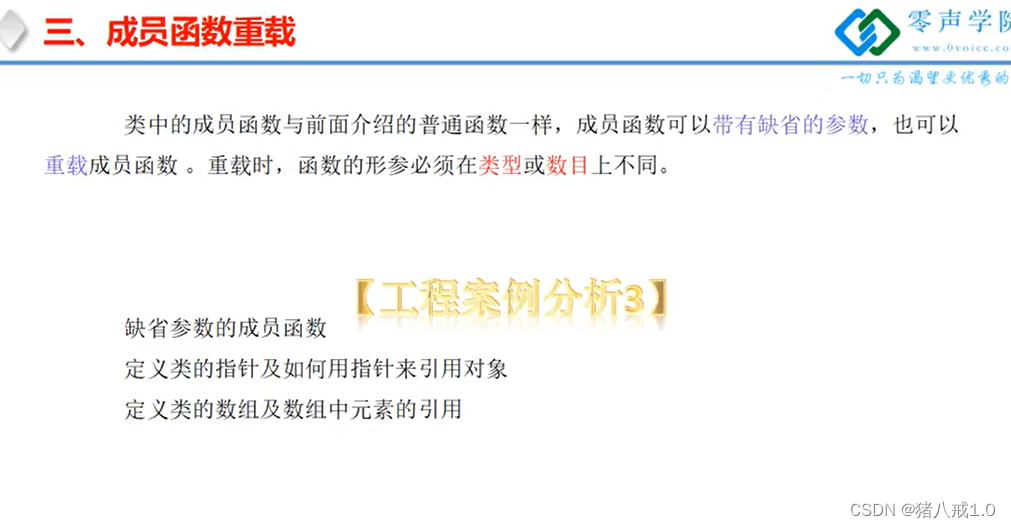目录
一、类的嵌套
二、对象引用私有数据成员
通过公有函数为私有成员赋值
利用指针访问私有数据成员
利用函数访问私有数据成员
利用引用访问私有数据成员
三、成员函数重载
四、this指针
一、类的嵌套

#include <iostream>
using namespace std;class CC1
{
public:int x;void Func();class CC2 {public:int x;void Func();}obc;
};void CC1::Func()
{x = 3000;cout << "x=" << x << endl;
}void CC1 :: CC2::Func()
{x = 4000;cout << "x=" << x << endl;
}int main()
{ CC1 obj;obj.Func();obj.obc.Func();cout << endl;cout << "2:x=" << obj.x << endl;cout << "2:x=" << obj.obc.x << endl;return 0;
}

二、对象引用私有数据成员
通过公有函数为私有成员赋值
#include <iostream>
using namespace std;//通过仅有函数为私有数据成员赋值
class CTest {int x, y;
public:void setxy(int a, int b){x = a;y = b;}void dispxy(){cout << "x=" << x << ",y=" << y << endl;}
};int main()
{CTest obj1;obj1.setxy(1, 2);obj1.dispxy();
}
利用指针访问私有数据成员
#include <iostream>
using namespace std;//利用指针访问私有数据成员
class CTest {int x, y;
public:void setxy(int a, int b){x = a;y = b;}void printxy() {cout << "x=" << x << ",y=" << y << endl;}void getxy(int* px, int* py) { //提取x y的值*px = x;*py = y;}};int main()
{CTest obj;obj.setxy(100, 200);obj.printxy();int m, n;obj.getxy(&m, &n);cout << "m=" << m << ",n=" << n << endl;
}
利用函数访问私有数据成员
#include <iostream>
using namespace std;//利用函数访问私有数据成员
class CTest {int x, y;
public:void setxy(int a, int b){x = a;y = b;}void printxy() {cout << "x=" << x << ",y=" << y << endl;}int getx() { return x; }int gety() { return y; }};int main()
{CTest obj;obj.setxy(100, 200);obj.printxy();cout << "x=" << obj.getx() << endl;cout << "y=" << obj.gety() << endl;}
利用引用访问私有数据成员
#include <iostream>
using namespace std;//利用引用访问私有数据成员
class CTest {int x, y;
public:void setxy(int a, int b){x = a;y = b;}void printxy() {cout << "x=" << x << ",y=" << y << endl;}void getxy(int& px, int& py) {px = x;py = y;}};int main()
{CTest obj;obj.setxy(100, 200);obj.printxy();int m, n;obj.getxy(m, n);cout << "m=" << m << endl;cout << "n=" << n << endl;
}
三、成员函数重载

#include <iostream>
using namespace std;class CTest
{int x, y;int m, n;
public:void setxy(int a, int b) {x = a;y = b;}void setxy(int a, int b, int c, int d) {x = a;y = b;m = c;n = d;}void dispxy(int x) {cout << x << "," << y << endl;}void dispxymn() {cout << x << "," << y << "," << m << "," << n << endl;}};
int main()
{CTest obj1, obj2;obj1.setxy(10, 20);obj2.setxy(10, 20, 30, 40);obj1.dispxy(666);obj2.dispxymn();return 0;
}

#include <iostream>
using namespace std;class CTest
{int x, y;public:void setxy(int a, int b) {x = a;y = b;}void dispxy(){cout << "x=" << x << "y=" <<y<< endl;}int sum(){return x + y;}};
int main()
{CTest obj1, obj2;//定义对象CTest* pobj; //对象类的指针(对象指针)pobj = &obj1;pobj->setxy(3, 4);pobj->dispxy();cout << "x+y=" << pobj->sum() << endl;return 0;
}

四、this指针

#include <iostream>
using namespace std;class CTest
{
private:int x;
public:int getx() const {return x;}void setx(int x) {this->x=x;cout << "this指针存储的内存地址为:" << this << endl;}
};
int main()
{CTest obj;obj.setx(888);cout << "对象obj在内存的地址为:" << &obj << endl;cout << "对象obj所保存的值为:" << obj.getx() << endl;return 0;
}







)

MeshRenderer、光照、Probes探针、UV信息、法线信息)








)
